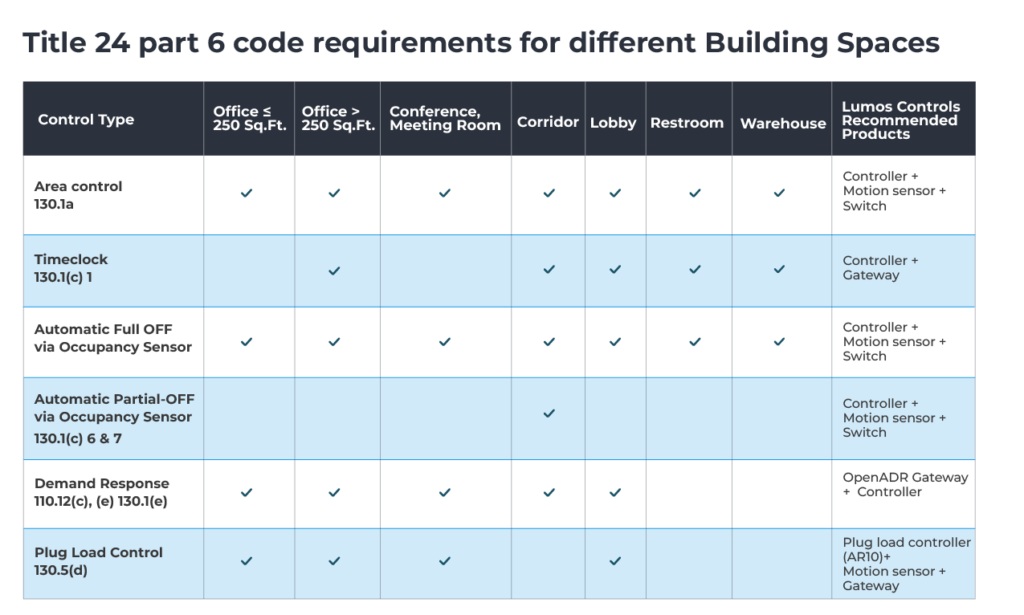Title 24 2023 Lighting Code Update: What Lighting Specifiers Need to Know?

Did you know that the latest version of Title 24 went into effect on January 1st, 2023? It’s called the 2022 version of California Energy Code and supersedes the previous 2019 version.
This building lighting code has significant implications for architects, lighting designers, and engineers who must ensure their projects meet the new requirements.
Have you started working on any projects that must comply with the new code? It can be a challenge, but it’s also an excellent opportunity to be more energy efficient and environmentally responsible.
Let’s talk about what’s changed for Title 24 (part 6) and how to stay comply with revised requirements.
What are the key changes in Title 24 part 6?
Title 24 mandates manual controls for areas, multi-levels, automatic shut-off, automatic daylighting, and demand-responsive controls. Before the 2023 edition, occupant sensing controls were mandatory for office spaces of 250 sq ft or smaller, while demand-responsive lighting controls were necessary for structures larger than 10,000 sq ft.
Click here for a detailed understanding of important lighting control requirements imposed by Title 24.
As of January 1, 2023, the two major changes in the latest version of Title 24, part 6 are:
1. A requirement for occupant-sensing controls in office spaces larger than 250 ft2 2. Revised requirements for demand-responsive controls |
Occupancy sensors in office space
Title 24 2023 latest updates mandates the use of occupancy sensors in all office spaces regardless of size, with a control zone of no more than 600 square feet for each sensor. This leads to greater energy efficiency compared to time-based controls and aligns with the latest International Energy Conservation Code (IECC).
Here is how it works:
- The sensor will activate the zone’s lighting to any desired level when it detects occupancy.
- Upon detecting the absence of occupants, the lighting in the zone must decrease to a minimum of 80% of its total power within a 20-minute period.
- Once the entire office area is unoccupied, the lighting in all zones must be shut off within 20 minutes.

A decrease in lighting of at least 80% in unoccupied areas is implemented so that even if one area is occupied while others are not, the office will still have some lighting for comfort. This decrease should be uniform across all unoccupied areas to maintain a consistent appearance.
Most occupancy sensors are designed to control lighting digitally through a room controller or networked control system. These sensors can be configured to work with different lighting fixtures and control zones through software or hardware. This allows for sensors to monitor specific control zones and adjust the zone size. This means that control zones can be easily programmed, added, or rearranged through the control panel or remotely using a computer or mobile phone, without the need for physical rewiring or use of ladders to access the systems.
Revised requirements for demand-responsive controls
The demand response strategy involves reducing the electrical load in a building in response to a control signal that comes from the electric utility. Earlier, only buildings with a floor space larger than 10,000 ft2 were required to have demand-responsive controls. However, under the updated code, all buildings with a total general lighting load of 4000W or higher must have demand responsive lighting controls installed.
An exception exists for spaces where reducing lighting may threaten health or safety, and their lighting power is not counted towards the 4000W threshold. Alterations and additions under 4000W are also exempt. Demand-responsive controls follow Section 130.1(b) requirements with exceptions for small areas, restrooms, and non-general lighting.
Here is how it works:
- When performing compliance testing, the lighting controls must be able to turn down the lighting power by at least 15% when they receive a signal.
- The signal must be bidirectional and may use a wired or wireless protocols
- The lighting control system must have a certified OpenADR 2.0a or 2.0b Virtual End Node (VEN) provided by the manufacturer that automatically performs the necessary control function. Alternatively, the lighting control manufacturer must prove that their system can react to a demand response signal from a different system’s OpenADR 2.0b VEN.
- In the event of communication breakdown, demand-responsive controls must still carry out all other specified control functions.
Title 24 Part 6 updated to include plug load controls in demand-responsive systems. Receptacles must be capable of turning off based on demand response signals. Plug load control is incorporated, but not mandatory. Small offices may not require demand-responsive lighting, but receptacles may need to connect to demand-responsive control.
Lumos Controls is committed to providing customers with energy-efficient and environmentally-friendly lighting solutions. Lumos Controls is an easy-to-specify energy code-compliant lighting control system that helps you comply with the big three energy codes and standards, ASHRAE 90.1, IECC, and Title 24. Read here to learn more.
Our products are Title 24 lighting code compliant, meaning they meet the strict energy efficiency standards set by the California Energy Commission. By using Lumos Controls’ Title 24 compliant products, customers can reduce their energy consumption, lower their electricity bills, and contribute to the effort of reducing greenhouse gas emissions.


Summary
This article highlighted two significant alterations in Title 24. For those in the lighting industry, such as designers, installers, and practitioners, Title 24 may be relevant to their upcoming renovation or new construction projects as it brings great savings on energy bills and improve building’s efficiency.
Click here to learn more about how Lumos Controls can help you comply with Title 24 and build futuristic buildings